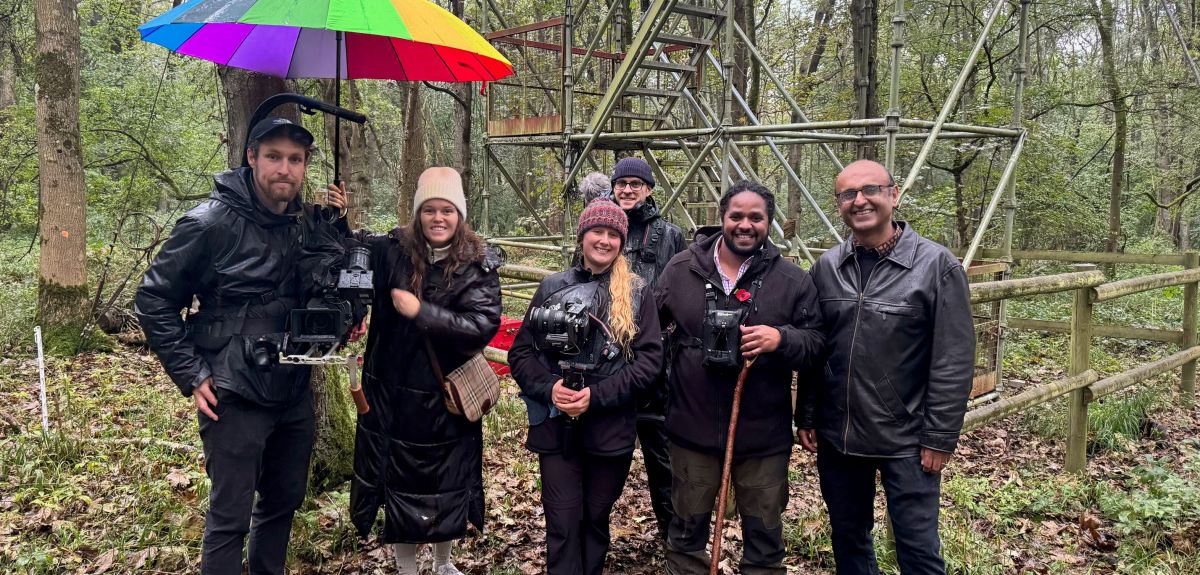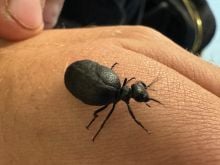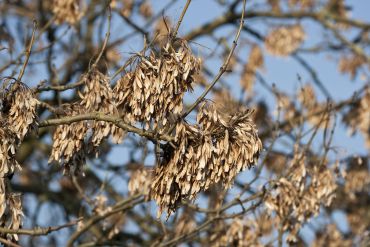
BBC Countryfile investigates at Oxford’s Wytham Woods
BBC's Countryfile visited scientists from Oxford’s Environmental Change Institute (ECI), at the University-owned Wytham Woods, to learn about the threat of ash dieback and the work at the site of special scientific interest – known as one of the most researched woodlands in the world.
The visit, shown on Sunday, 5 November's programme, focused on the threat of ash dieback to our ecosystems – and the BBC team heard about the rare creatures that live in the woods on the edge of the city, including the Rugged Oil Beetle (Meloe rugosus).
Professor Yadvinder Malhi, Ecosystems Research Programme Leader at the (ECI) and Tom Atkins, researcher at the University's Leverhulme Centre for Nature Recovery, shared what they have learned - during a four-year study at Wytham - with BBC presenters Hamza Yassin and Ellie Harrison.
The BBC team went up Wytham's Flux Tower, a scaffolding structure which allows researchers to measure the flows of carbon dioxide and water across the woods: the ‘breath of the woodland’.
Ash dieback is a silent pandemic affecting nature...Wytham is an ideal place to study ash dieback, both in how it is affecting the ash trees and also the wider ecosystem. And that is because the woods have such a long history of studies
Professor Yadvinder Malhi
Experts believe ash dieback will kill up to 80% of ash trees across the UK. At a cost of billions; the effects will be staggering. It will change the landscape forever and threaten many species which rely on ash.
Professor Malhi said, ‘Ash dieback is a silent pandemic affecting nature in Western Europe. Wytham is an ideal place to study ash dieback both in how it is affecting the ash trees and also the wider ecosystem. And that is because the woods have such a long history of studies…
'We are trying to bring together all those range of studies to understand that when you take out the ash trees, how does that cascade through an entire ecosystem.
'And I believe that with the ecosystem at Wytham Woods and the richness of the ecology and the interactions will be here for decades to come.'
 Talking about the rare beetle, Tom Atkins said, ‘The Rugged Oil Beetle is one of our strangest beetles, yet very few people have heard of it. Perhaps that’s because it only comes out at night during the winter months – I don’t blame people for not wanting to go out looking for it!'
Talking about the rare beetle, Tom Atkins said, ‘The Rugged Oil Beetle is one of our strangest beetles, yet very few people have heard of it. Perhaps that’s because it only comes out at night during the winter months – I don’t blame people for not wanting to go out looking for it!'
Because Rugged Oil Beetles are so specialised in their requirements, it suggests that the grassland at Wytham Woods is being managed well and could be an important refuge for this rare species
Tom Atkins
He added, 'It’s one of the UK’s five species of oil beetle, named because they secrete an incredible oily substance from their joints which deters predators. All have suffered large declines over the past century, mainly due to the loss of high-quality species-rich grassland habitats.’
'Because Rugged Oil Beetles are so specialised in their requirements, it suggests that the grassland at Wytham Woods is being managed well and could be an important refuge for this rare species.’
Ash dieback (Hymenoscyphus fraxineus) is a fungus which originated in Asia. It does not cause much damage on its native hosts of the Manchurian ash (Fraxinus mandshurica) and the Chinese ash (Fraxinus chinensis) in its native range. However, its introduction to Europe about 30 years ago has devastated the European ash (Fraxinus excelsior), because our native ash species did not evolve with the fungus and this means it has no natural defence against it.
Wytham Woods is such a big carbon sink because it is still recovering from intense land management prior to and during the Second World War before, and is now benefiting from a focus on conservation since the 1960s.
 Ash Die Back.
Getty Images
Ash Die Back.
Getty ImagesWytham Woods has been owned and maintained by the University of Oxford since 1942. The Woods are often quoted as being one of the most researched pieces of woodland in the world, and their 1000 acres are designated as a Site of Special Scientific Interest. The site is exceptionally rich in flora and fauna, with over 500 species of plants, a wealth of woodland habitats, and 800 species of butterflies and moths. The exceptional detail of research there reveals nationally rare animals.
 New Year Honours 2026
New Year Honours 2026
 New study estimates NHS England spends 3% of its primary and secondary care budget on the health impacts of temperature
New study estimates NHS England spends 3% of its primary and secondary care budget on the health impacts of temperature
 International collaboration launches largest-ever therapeutics trial for patients hospitalised with dengue
International collaboration launches largest-ever therapeutics trial for patients hospitalised with dengue
 Oxford-built multi-agent assistant for cancer care to be piloted in collaboration with Microsoft
Oxford-built multi-agent assistant for cancer care to be piloted in collaboration with Microsoft